By Carole Joffe, University of California, San Francisco
On the first day of the new Congress in January, anti-abortion legislators in the House introduced the Pain Capable Unborn Child Protection Act. The bill would have banned abortions after 20 weeks, except for those due to rape, incest or threats to the life of the pregnant woman.
The House had planned to vote on this measure on January 22, the anniversary of the Roe v Wade decision, but at the last minute canceled the vote. GOP lawmakers, many of them women, objected to the stringent rape reporting requirement included in the act.
Reports suggest, however, that this is not the end of the story for the federal 20 week ban and that a modified version of this bill will be voted on at a later date.
Why now?
The 20 week ban is being promoted by abortion opponents because they know it will not only please the extremely important social conservative base of the Republican Party, but will also receive public support.
Although polls show that a majority of Americans want to keep abortion legal, they also show that 64% of Americans would favor making abortion illegal in the second trimester, indicating it is an emotionally charged issue for many.
But one might also question whether a federal 20 week ban is really needed.
According to the Centers for Disease Control and Prevention, abortions performed at 21 weeks or after account for only 1.4% of all such procedures.
Consider also that abortion has been massively regulated by state legislatures in recent years, with 231 laws passed between 2011 and 2014. These 20 week bans have already passed in 14 states, though lower courts have blocked them in the three places where they’ve been challenged.
Why women seek abortions after 20 weeks
Some women seeking abortions after 20 weeks are doing so for medical reasons. They may have just learned of lethal or serious fetal anomalies. Or they may become very ill themselves, with the pregnancies posing a further risk to their health.
Money is also a factor. Desperately poor women who have trouble finding the funds for an earlier abortion are pushed into a later one as time passes while they gather payment.
In other cases, wanted pregnancies can turn into unwanted ones for personal reasons: the death of a partner, for example, or the serious illness of a child that makes it difficult to contemplate also caring for a newborn.
Junk science and questionable ‘experts’
The rationale for such bans is that the fetus can feel pain at 20 weeks. This claim has been roundly disputed by medical experts, and by organizations such as the American College of Obstetricians and Gynecology (ACOG). The consensus among these experts is that fetal pain is unlikely before the third trimester (27 weeks).
In pushing for a 20 week ban, anti-abortion politicians are following a tried and true playbook: choose an aspect of abortion provision that is unsettling to a public that is not informed about the science, ignore the testimony of leading medical experts on the abortion issue, and instead, rely on arguments made by alternative “experts,” who may lack the credentials or research background in their purported areas of expertise or draw on so-called junk science.
These kinds of questionable witnesses have been involved in state hearings on legislation banning abortion at 20 weeks.
In 2014 judges criticized the states of Alabama and Texas for using these kinds of witnesses to testify in favor of restrictive abortion policies.

Kevin Lamarque/Reuters
A new ban with an old playbook
This model worked very effectively in the so-called “partial birth abortion” debate a decade ago. In that case, state legislatures and, eventually, Congress passed measures banning the use of a relatively rarely used method of abortion, known in the medical world as Intact Dilation and Evacuation (D&E).
Abortion opponents sensationalized the procedure (“partial birth abortion” is a term that appears nowhere in medical literature) and drew on witnesses – who had never performed an abortion using that method, or, in some cases, any abortions at all – who claimed the method was never necessary.
Medical experts from the abortion-providing community testified that in certain situations, this method was the safest, and medical organizations submitted briefs opposing the ban. Bill Clinton vetoed this bill, but it was signed into law by George W Bush in 2003.
The ban did not include exceptions for the health of the woman – cases where the procedure may be medically necessary and safer for the woman than an alternative. The ban was challenged, and lower court decisions found that it was unconstitutional because it lacked such an exception.

Jonathan Ernst/Reuters
Medical exceptions, shoddy science and the Supreme Court
In 2007 the Supreme Court, in Gonzales v Carhart, heard a challenge to ban.
The court acknowledged that Congress’s findings on the the procedure were wrong, including the assertion that the medical consensus is that the procedure is is never medically necessary. Despite this and the fact that the act contains no health exemption, the court still upheld the law in a 5-4 decision.
It was an unprecedented interference with medical practice on the part of the Court. This decision was particularly disheartening to the abortion rights community.
Justice Anthony Kennedy also seemed to offer legitimacy to a prime example of junk science in the abortion debate: abortion regret syndrome. Writing for the majority, Justice Kennedy, acknowledged that “we find no reliable data to measure the phenomenon,“ while arguing “it seems unexceptionable to conclude some women come to regret their choice to abort the infant life they once created and sustained.”
The American Psychological Association has repeatedly debunked claims that elective abortion “in and of itself causes mental health problems in adult women.” Another major study found that the studies supporting the existence “abortion trauma sydnrome” were riddled with methodological flaws. This study, and others, have found that the best predictor of a woman’s mental health after an abortion is her mental health before the procedure.
What comes next?
The unusual abrupt cancellation of the vote on the 20 week ban bill (which was hastily replaced by another vote on abortion funding) revealed interesting splits within the House Republican caucus, and particularly the concerns of Republican women in swing districts that the exceptions permitted appeared too narrow.
Republican leaders announced that the 20 week ban measure would be voted on at a later, unspecified time. Very likely, the newer version will contain looser requirements for exceptions based on both rape and incest.
Given the present composition of the Senate and a Democratic president in the White House, the federal 20 week ban will not become law if it is re-introduced before the 2016 elections.
But such a ban could very well succeed in the future, depending on the outcome of elections and, particularly, appointments to the Supreme Court. The passage of the numerous abortion restrictions since Roe reveal not only a disregard of the women affected, but also of the health professionals who seek to care for them.
![]()
This article was originally published on The Conversation.
Read the original article.





